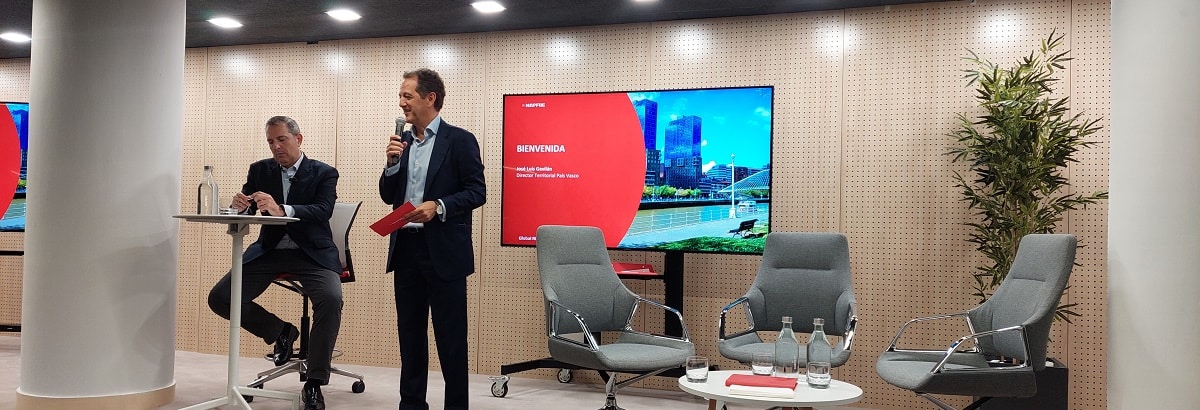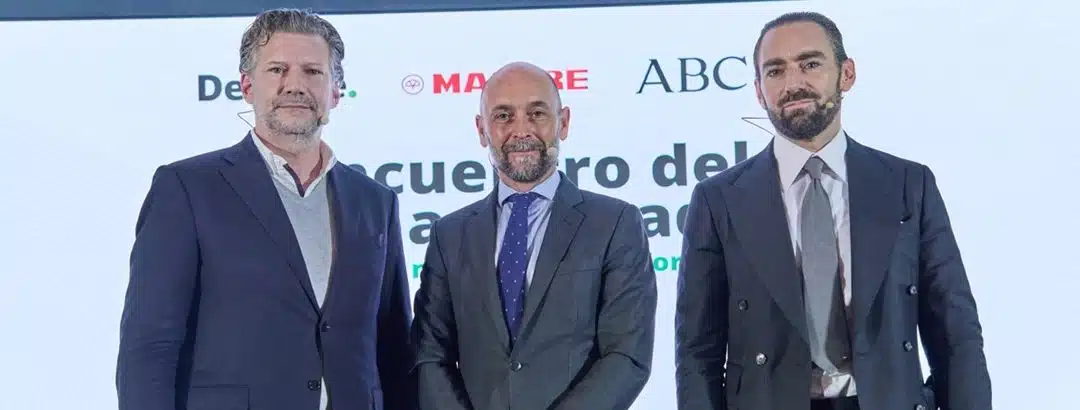Julia Maria Gomez de Avila Segade | 16/10/2025
The Global Risks Bilbao conference was launched two years ago with the aim of establishing a forum for dialogue on key risks affecting the insurance industry in the Basque Country.
On September 23, the second edition of Global Risks Bilbao was held, featuring discussions on current topics and insights into how to address the challenges of the energy transition from an insurance standpoint.
Energy transition and risk management: challenges and opportunities for the insurance industry
The energy transition is progressing steadily in Spain. In 2024, 57% of the country’s electricity generation came from renewable sources, with a target of reaching 75% by 2030. However, certain regions face geographic and climatic constraints that limit their renewable generation capacity. Even so, the Basque Country is home to numerous investment, industrial, and service groups that play an active role in this sector.
This context presents significant challenges for the insurance industry, which must adapt to an ever-evolving regulatory, technological, and financial environment.
Renewable energy projects are exposed to a range of complex and dynamic risks. Among the main factors affecting their viability and insurability are:
- Changes in the regulatory framework and their impact on financing.
- Continuous equipment innovation, which makes it difficult to establish historical data on claims levels and repair costs.
- Climate change and the associated catastrophic events.
- Interest rate volatility.
- The entry of mutual funds with specific return expectations.
- Strains in supply chains and shortages of specialized labor.
These elements require proactive and collaborative risk management, where customers, brokers, and insurance companies work together to identify, quantify, and mitigate risks from the earliest stages of each project.
The broker’s role as a strategic consultant
In this new paradigm, the broker is no longer a mere intermediary but a strategic consultant. Their early involvement—from the design stage through contractual negotiation—makes it possible to align coverage terms with financing requirements and the customer’s operational needs. This role is particularly relevant with the introduction of new technologies, such as battery storage systems, and the growing internationalization of projects.
Insurance in renewable projects: construction and operation
Managing insurance for renewable energy projects requires careful coordination between the construction and operational phases. While MAPFRE generally favors separate policies, hybrid solutions are also available in the market. The transition between phases can create gray areas that must be clearly defined in contractual terms—specifying coverage periods, the parties involved, and certification procedures for completed works.
Aging renewable facilities: a segment with potential
The insurance market faces the challenge of adapting its products to renewable facilities that have been operating for more than 20 years. Although these infrastructures are based on outdated technologies, their risk profiles are better known and easier to manage. Since repowering is progressing slowly in Spain, it is essential to anticipate spare parts management and adapt coverage to the specific characteristics and needs of this segment.
Catastrophic risk management and international programs
In the international arena, catastrophic (CAT) risk management becomes especially complex. Placing coverage in demanding markets requires technical expertise and specialized advisory support. The decision between local solutions and global programs should be based on the project’s location and complexity, always supported by risk modeling that justifies the limits required by financiers.
Improvement in claims management: protocols and technical presence
Continuous improvement in claims management is a shared goal across the insurance industry. Establishing pre-agreed action protocols and clear communication flows helps streamline responses and prevent misunderstandings. The on-site presence of technical leads and brokers at the scene of a claimable event is essential to gather first-hand information and support the customer through critical moments.
Post-claim analysis sessions are also a valuable tool for identifying opportunities to improve procedures, coverage, and communication—contributing to a more effective and resilient approach to risk management across the industry.
Risks in photovoltaic installations: design, execution, and maintenance
Claims in photovoltaic installations often stem from design flaws, assembly errors, or inadequate maintenance. Proper technical execution and compliance with established standards are essential to prevent electrical and mechanical incidents that could compromise the integrity of the installations, as well as to mitigate fire risk.
Fire protection in photovoltaic systems requires a comprehensive approach. Key recommendations include:
- Proper system design.
- Installation of fire detection and extinguishing systems.
- Avoiding the installation of photovoltaic panels on combustible sandwich roofs.
- Rigorous supervision and technical oversight at every project stage.
These measures help reduce fire risk, improve response times, and limit fire spread.
Regulations and standards: towards a more effective regulation in photovoltaic systems
Current mandatory Spanish regulations still have room for improvement when it comes to the design and installation of photovoltaic systems, as some requirements do not yet address the specific risks inherent to these technologies. Therefore, it is recommended to:
- Apply recognized international standards.
- Strictly comply with manufacturers’ manuals.
- Avoid poor practices, such as installing accessories or components not recommended by the photovoltaic system manufacturer.
- Hire specialized companies for the design, installation, and maintenance of photovoltaic systems.
Photovoltaic technology is not inherently hazardous, but its risks increase significantly when design, installation, maintenance, or inspections are neglected.
Lithium-ion batteries: specific risks and technical management
Lithium-ion batteries have become the most widely used battery technology across multiple sectors, including automotive, energy generation, communications, industry, and even private applications.
However, they present specific risks, such as the thermal runaway phenomenon, which can trigger fires that are extremely difficult to extinguish and, in some cases, explosions. To mitigate these risks, it is generally recommended—depending on the application—to ensure:
- High-quality materials and manufacturing processes.
- Proper management of batteries throughout their entire life cycle.
- Use of battery management systems (BMS) with integrated safety interlocks.
- Adequate compartmentalization and separation of battery storage areas.
- Installation of early “off-gas” detection systems with safety interlocks.
- Installation of fire detection and extinguishing systems.
- Periodic technical audits.
The complexity of these systems requires the involvement of specialists from the design phase onward, along with continuous monitoring and supervision throughout their operational life.
It is important to emphasize that these are technologies in continuous evolution, posing a significant challenge not only for prevention and protection, but also for risk engineering.
Conclusions
Experts agree that the energy transition requires a comprehensive approach across all stages of a project—from design to operation—whether for large-scale plants or self-consumption installations. Collaboration among insurers, brokers, clients, and technical specialists is essential to anticipate potential risks, implement best practices, and tailor coverage to the unique characteristics of each project.
The insurance market is likewise urged to keep innovating and evolving, adapting its products and processes to new technological challenges. Finally, active listening to customers’ needs and participation in technical risk assessments will be key to ensuring a safe and sustainable energy transition.





